Canon III, IIC, IV Rangefinder Cameras of 1951
A Description of three new Canon models introduced in 1951
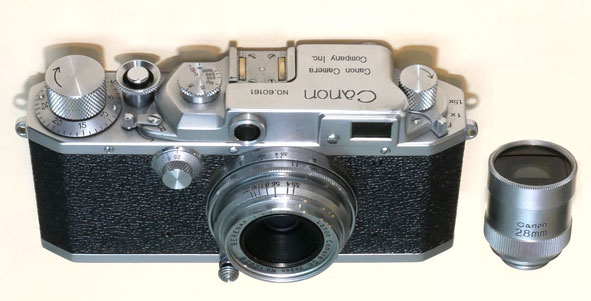
Canon III of 1951 with 28mm f3.5 lens and finder of 1952
Introduction of Three New Cameras in 1951
In 1951, Canon introduced three new cameras using a new focal-plane shutter design which featured for the first time a 1/1000 second speed. These cameras continued to use a high speed shutter dial on the camera top and a slow speed dial on the front, but split at 1/25 second rather than the previous 1/20 second. The high speed shutter used a coated cloth shutter curtain. A 'T' time exposure setting was also added to the slow speed dial.
Canon III
First of the 1951 introductions was the Canon III launched in February 1951. 4. The bodies of the Canon III, IIC, and IV were new and had a small hole below the lens mount opening for a flash synchronization wire into the new shutter, a groove along the bottom front of the body for the synchronization wire, and holes below the film rewind knob for attachment of a new synchronizing flash rail. The Canon III did not feature flash synchronization, so these body openings were filled with white grout.
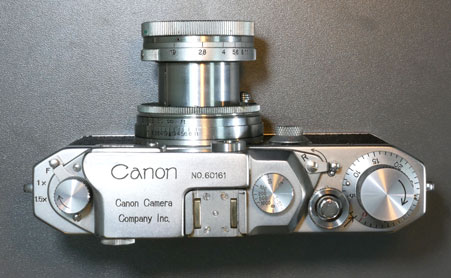
Canon III top with 1/1000 second high speed shutter dial
The Canon III continued to have the three position 'F' for normal 50mm finder image, '1.5x' for magnified focusing and a 135mm telephoto finder image, and '1x' for a 100mm medium telephoto finder image. The two piece viewfinder switch was the same as for the Canon IIB.
The Canon Rapid Winder
The take-up film shaft of the Canon III had a notch for rapid film advance. The camera base plate could be removed and the Canon Rapid Wind Baseplate could be fitted which connected to the notch in the take-up shaft to allow rapid film advance using the trigger of the rapid winder.
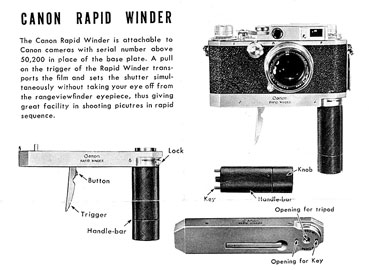
Canon Rapid Wind Baseplate which fitted first to the Canon III, then to later models
Canon IIC
Introduced in 1951 with the same new body construction of the Canon III and IV, the Canon IIC was intended to be a lower priced version of the Canon series. It did not have the 1/1000 second speed, but did use the new shutter, with the split at 1/25 second. In all other aspects, it was identical with the Canon III. Since the popular Canon IIB continued production during this period, there was not much place for the Canon IIC, and it was produced for only five months: March to August 1951 with 800 units manufactured. 1
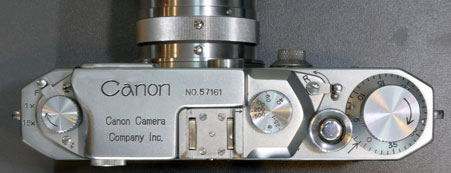
the short-lived Canon IIC showing the 1/500 second top speed
Canon IV
Most important among the 1951 new model releases was the Canon IV, along with the Canon 1950, these were the first Canons to be delivered from the Canon factory with flash synchronization.
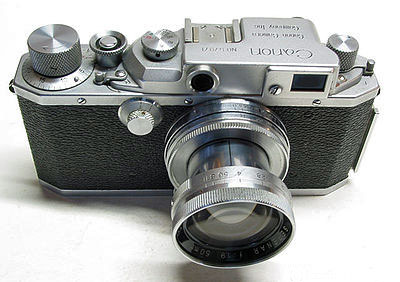
Canon IV shown with the new flash synchronization rail positioned below the rewind knob
As with the Canon 1950, introduced the prior year, and the other new Canon cameras of 1951, the Canon IV featured the following innovations:
- a new shutter with speeds to 1/1000 second in two shutter dials, split at 1/25 second, rather than the previous 1/20 second.
- addition of a T time exposure to the slow speed dial
- a new rewind mechanism, with an A-R (advance-rewind) lever added to the camera cover.
Peter Dechert reports 1 that only 1,400 unitis of the Canon IV were manufactured, making it one of the more difficult models for collectors to find.
Flash Synchronization
This synchronization connection was made by a vertical bar attached to the camera side into which could be slid a Canon flash unit. Synchronization was for flash bulbs; not for the later developed electronic flash. Canon also developed several versons of a flash gun which would slide into this flash bar.
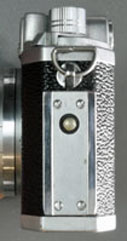
Synchronization was for flash bulbs; not for the later developed electronic flash. Canon also developed several versons of a flash gun which would slide into this flash bar.
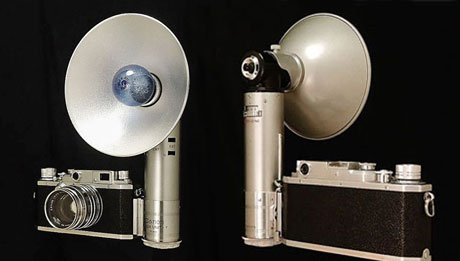
You can click on the links in the table below to consult other pages of the canonrangfinder.org site.
| Navigation: Click Below to Jump to Desired Subject Page | ||
|---|---|---|
| Canon Rangefinder Cameras - 1 | Canon Rangefinder Cameras - 2 | Canon Rangefinder Lenses |
| Canon S | Canon IVSB2 | Canon 19mm |
| Canon J | Canon IIS2, IID2, IIF2 | Canon 25mm |
| Canon NS | Canon VT, Canon L2 | Canon 28mm |
| Canon JS | Canon L1, L3 | Canon 35mm |
| Canon J-II | Canon VT Deluxe | Nikkor 50mm |
| Canon S-II | Canon VL, VL2 | Canon 50mm |
| Canon IIB | Canon VI-L, VI-T | Canon 85mm |
| Canon III, IIC, IV | Canon P | Canon 100mm |
| Canon IIIA, IVF, IVS | Canon 7 | Canon 135mm |
| Canon IIA, IID, IID1 | Canon 7s | Canon 200mm-1000mm |
| Canon IVSB | Minolta Rangefinders | Minolta Lenses |
| Canon IIF, IIS | Other Rangefinders | other M39 lenses |
| Go to canonrangefinder.com home page | ||
Any additions or corrections to these pages would be welcome simply by contacting this site as shown at the foot of this page .
Footnotes:
1 Dechert, Peter. Canon Rangefinder Cameras 1933-1968. Hove Collectors Books. West Sussex, United Kingdom. 1985. ISBN 0-906447-30-5.
Peter Dechert's book is the most important expert source of information regarding Canon Rangefinder Cameras.
2 Kitchingman, Peter. Canon M39 Rangefinder Lenses 1939-1971. A Collector's Guide. Published by Peter Kitchingman. Perth, Australia. 2008. ISBN 978-0-646-48144-9.
Peter Kitchingman's book is the definitive study of the more than three decades of M39 format camera lenses developed for Canon Rangefinder Cameras.
3 Nostalgic Canon Camera Book. 懐かしいキヤノン EI Publishing Co. Ltd. Tokyo, Japan. June 2003.
Peter Kitchingman's book is the definitive study of the more than three decades of M39 format camera lenses developed for Canon Rangefinder Cameras.
4 "Canon Camera Museum" history website. https://global.canon/en/c-museum/history/ published by Canon, Inc. accessed in 2019.
5 Rajner, Hans P. (author), John Wade (editor). Leica Copies. Classic Collections Publications. London, UK. ISBN 13: 9781874485056
Hans P. Rajner's book is an excellently detailed and carefully researched study of camera from around the world which used the Leica M39 lens mount and the same lens to film plane distance.
7 Dechert, Peter. Canon Single Lens Reflex Cameras 1959-1991. Historical Camera Publications. Yakima, Washington. 1992. ISBN 1-879561-04-2.
8 Tomlinson, Shawn M. The Film Photography Book. Lulu Pulbications. 2016. ISBN: 9781365263972
9 Sartorius., Ghester. Identifying Leica Lenses. Classic Camera 19. Tokyo, Japan. 2001. ISBN 4-257-12029-0
10 website http://www.nicovandijk.net/rflensmatrix.htm consulted 2019.
11 O'Reagan, Douglas M. Allied Exploitation of German Science after World War II. Johns Hopkins University Press. Baltimore, Maryland. 2019. ISBN 9781421428888
12 website www.canonrangefinder.servehttp.com consulted 2008.
13 Minolta expert Andrea Aprà has posted information on minoltarangefinders group and other groups and further detailed information by email. (thanks Andrea !)
14 website http://www.collection-appareils.fr/objectifs/ consulted 2019.
15 Small, Marc James. Non-Leitz Leica Thread-Mount Lenses. Wittig Books. Hückelhoven, Germany. 1997. ISBN 3-930359-47-2.
16 the Nikon Corporation website: https://imaging.nikon.com/history/ consulted 2019.
17 p 152. Ray, Sidney F. Photographic Lens ISBN 9780240510323
18 website http://www.rokkorfiles.com/Lens%20History.html accessed 2019
19 p. 10. Dechert, Peter. The Contax Connection. The History of the Japanese Camers. Historical Camera Publications. 1 August 1990.
If you have any comments or questions about this Canon Rangefinder site, please e-mail me (Larry Huffman) at e-mail address: [email protected]